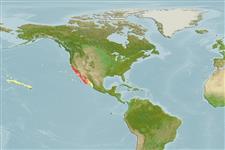Elasmobranchii (sharks and rays) >
Carcharhiniformes (Ground sharks) >
Scyliorhinidae (Cat sharks)
Etymology: Parmaturus: Latin, parma, -ae = a little shield + Greek, oura = tail.
Environment / Climate / Range
Ecology
Marine; demersal; depth range 88 - 1250 m (Ref. 96339). Subtropical, preferred ?; 39°N - 20°N
Eastern Central Pacific: central California, USA to the Gulf of California.
Length at first maturity / Size / Weight / Age
Maturity: Lm ?, range 43 - 47.5 cm
Max length : 45.0 cm TL male/unsexed; (Ref. 244); 55.0 cm TL (female)
Found on the outer continental shelf and upper slope. Feeds on a variety of small fish (e.g. lanternfish) and invertebrates. Oviparous. Possesses an enlarged gill region which is an adaptation to areas with low dissolved oxygen levels. Has a high concentration of squalene in its liver which affords it neutral buoyancy. Regularly caught by bottom trawlers but not utilized at all.
Life cycle and mating behavior
Maturity | Reproduction | Spawning | Eggs | Fecundity | Larvae
Oviparous, paired eggs are laid. Embryos feed solely on yolk (Ref. 50449).
Compagno, L.J.V., 1984. FAO Species Catalogue. Vol. 4. Sharks of the world. An annotated and illustrated catalogue of shark species known to date. Part 2 - Carcharhiniformes. FAO Fish. Synop. 125(4/2):251-655. Rome: FAO. (Ref. 244)
IUCN Red List Status (Ref. 115185)
CITES (Ref. 94142)
Not Evaluated
Threat to humans
Harmless
Human uses
Fisheries: of no interest
More information
Age/SizeGrowthLength-weightLength-lengthLength-frequenciesMorphometricsMorphologyLarvaeLarval dynamicsRecruitmentAbundance
ReferencesAquacultureAquaculture profileStrainsGeneticsAllele frequenciesHeritabilityDiseasesProcessingMass conversion
Tools
Special reports
Download XML
Internet sources
